
| Component | Description | Component | Description |
|---|---|---|---|
| Touchscreen Display | High-resolution screen for browsing menus, customizing orders, and making selections. | Payment Terminal | Processes payments via credit/debit cards, mobile payments, or NFC technologies. |
| Receipt Printer | Prints order confirmations and receipts for customers after transactions. | Processor/CPU | Controls software operations, ensuring smooth and efficient order processing. |
| Chassis/Enclosure | Durable outer casing that houses all components and provides security. | Connectivity Modules | Enables network communication for order transmission and software updates. |
Design and Planning: Engineers and designers create detailed plans, focusing on user interface, ergonomic design, and the integration of hardware components like touchscreens, printers, and payment terminals.
Component Selection: High-quality components such as touchscreens, processors, printers, and payment terminals are selected to ensure durability and performance.
Prototyping: A prototype of the kiosk is built to test the design, functionality, and usability. Adjustments are made based on feedback and performance testing.
Software Development: Custom software is developed to manage the kiosk’s interface, payment processing, and connectivity with the point-of-sale (POS) system. This includes menu displays, order customization, and payment integration.
Assembly: The kiosk is assembled by integrating the selected hardware components into the chassis. Wiring, mounting, and securing of internal parts are carefully performed.
Quality Control and Testing: Each kiosk undergoes rigorous testing for functionality, durability, and security. This includes testing the touchscreen, payment processing, printer reliability, and software performance.
Installation and Deployment: Once manufacturing and testing are complete, the kiosks are shipped to the customer’s location, where they are installed, configured, and connected to the store's network, ready for customer use.

Quick Service Restaurants: Allows customers to place and customize their orders, reducing wait times and improving order accuracy.
Cafes and Coffee Shops: Enables patrons to order drinks and snacks directly from the kiosk, streamlining service during busy periods.
Fast Food Chains: Facilitates fast, efficient ordering for high-volume environments, helping to manage peak times and reduce lines.
Casual Dining: Provides a convenient way for guests to browse the menu, place orders, and pay without needing to wait for a server.
Movie Theaters: Lets customers purchase tickets and order concessions, enhancing the overall movie-going experience.
Airports and Travel Hubs: Offers travelers a quick way to order meals and snacks on the go, improving service speed in high-traffic areas.
Hotel Room Service: Allows guests to order food, drinks, and other services directly from a kiosk located in the lobby or even in their rooms.
Retail Food Courts: Streamlines the ordering process in busy food courts, enabling customers to quickly select and pay for their meals from multiple vendors.
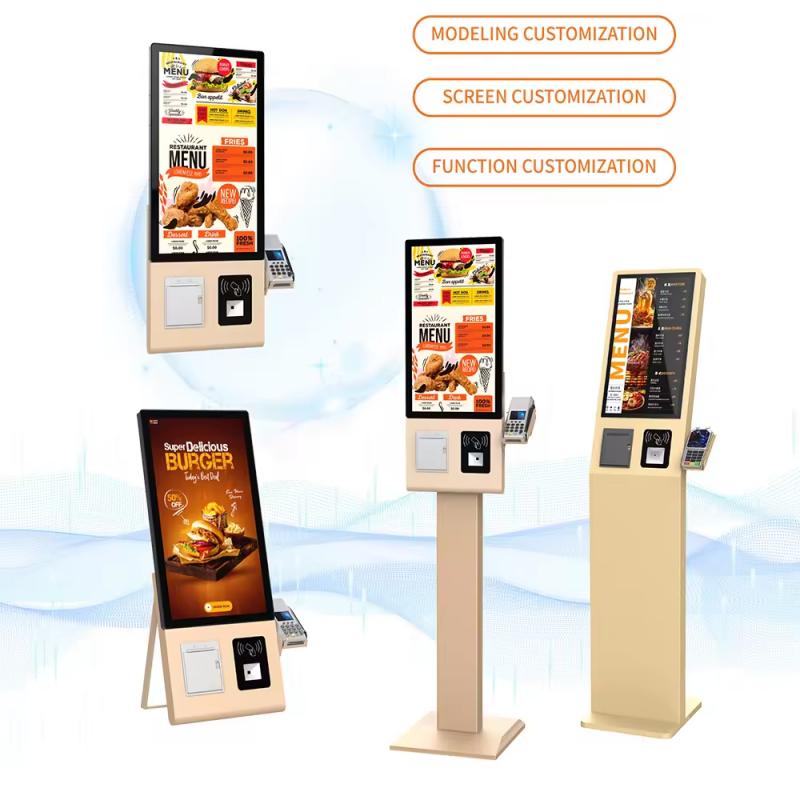
| Type | Description | Typical Size (Height x Width x Depth) | Use Case |
|---|---|---|---|
| Freestanding Kiosk | A standalone unit designed for high-traffic areas, offering full menu and payment capabilities. | 60” x 24” x 18” | Quick service restaurants, fast food chains. |
| Countertop Kiosk | A compact unit placed on a counter, ideal for smaller spaces with limited floor area. | 24” x 15” x 12” | Cafes, small restaurants, retail environments. |
| Wall-Mounted Kiosk | Mounted on walls to save floor space, providing ordering and payment functionality. | 48” x 20” x 8” | Casual dining, coffee shops, food courts. |
| Outdoor Kiosk | Weather-resistant unit for outdoor use, designed to withstand environmental factors. | 70” x 30” x 20” | Drive-thrus, outdoor dining areas, stadiums. |
| Tabletop Kiosk | Small, portable kiosks placed on tables, allowing customers to order from their seats. | 18” x 10” x 8” | Casual dining, bars, and food halls. |
| Multi-User Kiosk | A larger unit with multiple screens or interfaces for simultaneous use by several customers. | 72” x 40” x 20” | High-volume areas like food courts or airports. |
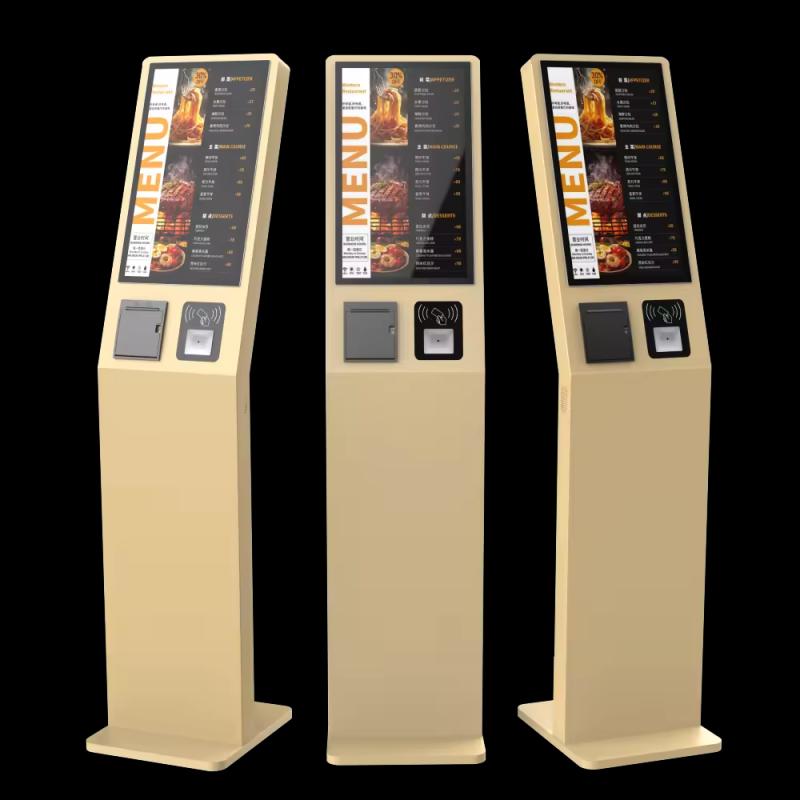
Approach the Kiosk: Start by standing in front of the touchscreen kiosk and waking it up if needed by touching the screen.
Browse the Menu: Use the touchscreen to scroll through the available menu items, categories, and special offers.
Select Your Items: Tap on the items you want to order. You can customize your selection by adding or removing ingredients, choosing sizes, or selecting combo options.
Review Your Order: After selecting your items, review the order summary on the screen to ensure everything is correct. Adjust quantities or remove items if necessary.
Proceed to Payment: Once satisfied with your order, tap on the "Checkout" or "Pay Now" button. Follow the prompts to select your preferred payment method (credit/debit card, mobile payment, etc.).
Complete the Transaction: Insert or tap your card on the payment terminal, or follow the instructions for mobile payments. Wait for the payment to process and for your receipt to print.
Collect Your Receipt and Order Number: After the transaction, retrieve your printed receipt and order number. Wait for your order to be prepared, and collect it when your number is called or displayed.
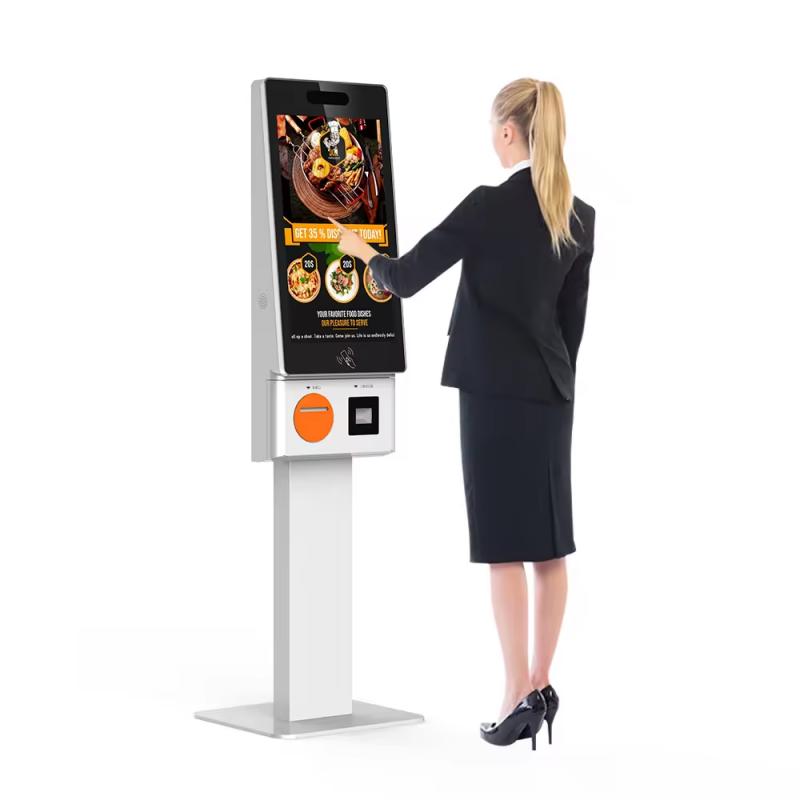
Screen Size and Resolution: Choose from various screen sizes and resolutions to match the kiosk’s placement and user needs, enhancing visibility and ease of use.
User Interface Design: Customize the touchscreen interface with branded colors, logos, and tailored menus to provide a cohesive customer experience and align with your brand identity.
Payment Methods: Integrate different payment options such as credit/debit cards, mobile payments, cash acceptors, or contactless payments to cater to diverse customer preferences.
Hardware Features: Options include different types of printers (receipt or ticket), barcode scanners, or additional input devices depending on your operational needs.
Enclosure Design: Select from various enclosure materials and designs to suit different environments (e.g., weather-resistant materials for outdoor use).
Accessibility Features: Add features like audio prompts, adjustable heights, or accessibility modes to accommodate users with disabilities.
Integration Capabilities: Ensure the kiosk can integrate with existing POS systems, inventory management, and CRM systems for seamless operation and data flow.
Software Customization: Tailor the software to include specific functionalities, such as loyalty program integration, upselling prompts, or multilingual support.
Functionality Requirements: Assess your specific needs such as menu complexity, transaction volume, and additional features like loyalty programs or inventory tracking.
Budget: Determine your budget, including initial purchase cost, installation, customization, and ongoing maintenance.
Vendor Reputation: Research vendors for reliability, product quality, customer service, and support. Look for reviews and case studies from similar businesses.
Integration Needs: Ensure the kiosk integrates seamlessly with your existing systems (POS, inventory, CRM) and supports required payment methods.
Ease of Use: Choose a kiosk with a user-friendly interface that minimizes training time and enhances the customer experience.
Security Features: Verify that the kiosk includes robust security measures to protect payment information and prevent unauthorized access.
Durability and Maintenance: Opt for a kiosk built with durable materials and check the warranty and support services offered to handle potential issues.
Scalability: Consider whether the kiosk can be easily upgraded or expanded in the future as your needs evolve.



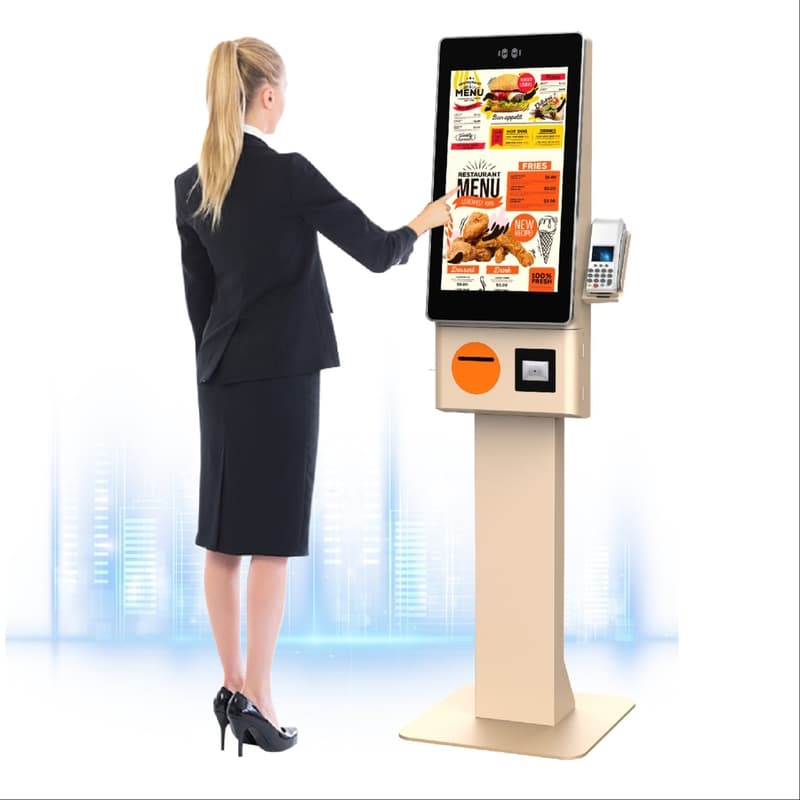

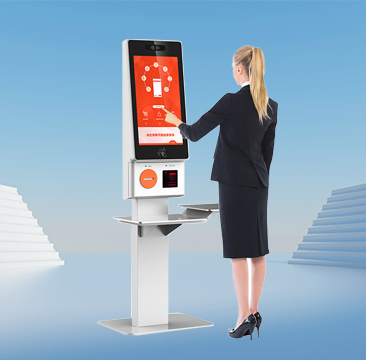
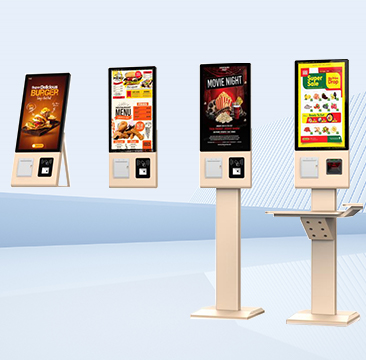

What did our happy clients say?
We’re extremely satisfied with our new self-ordering kiosk! It’s streamlined our service and enhanced customer satisfaction. Thanks for the great support and reliable product!
The self-ordering kiosk has exceeded our expectations. It’s easy to use and has improved our efficiency. Huge thanks to the team for their excellent service and timely delivery!
Our new self-ordering kiosk is fantastic—customer feedback has been overwhelmingly positive. We appreciate the seamless installation and outstanding support. Highly recommend!
We’re thrilled with our self-ordering kiosk! It’s user-friendly and has significantly sped up our service. Thank you for the exceptional product and support throughout the process!